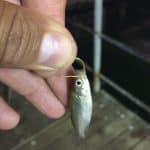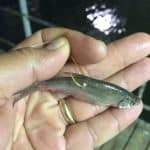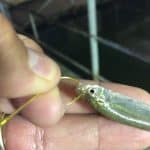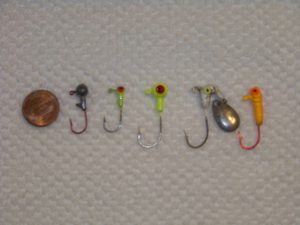Hello fellow crappie fishermen/women. This post is going to focus on crappie fishing bait. The purpose is to break down the different types of bait and when/how to use them to catch crappie. At the end of this article I will share some of my favorites.

I know tons of crappie fisherman that are partial to one or the other. There are those that exclusively use jigs with plastics. Their mantra is “feel the thump”. Truth be told, it is very exciting to catch a crappie on a plastic lure. You have to have a certain amount of skill to react just right when you feel a bite. You need to move fast, yet be gentle enough not to rip through the thin membrane. Crappies are not called papermouths for nothing.
Others prefer live bait exclusively. Their position is that live minnows are the natural diet of crappies. Because of this, they are the best bait to use. Others have had success with grubs, crickets and worms to catch crappie. I cannot say that I have had much success with any live bait other than minnows but that is just me.
My position is, why not both. Sometimes crappie hit minnows exclusively, while other times they seem to gravitate to plastics. I like to have options so I always have both.
Live Bait – When and How
I will focus strictly on minnows since that is what I have had the most success with. It is also what I use the most. They are extremely easy to find and are pretty inexpensive to boot. You can find them at bait shops but you can also find them at pet stores. The pet store varieties are interesting because sometimes they come in a shade of orange that crappie find pretty interesting.
First lets focus on size. It is true that crappie will hit just about any size of minnows. I have caught a ton of 8 inch crappie on big 3 inch minnows. During the spring spawn, they are so aggressive they will attack anything. In the summer and the winter they can be a bit more finicky.
Generally speaking I find that 2 inch minnows (give or take a quater inch) are the best size to use. Here in Texas we buy them by the dozen (for $2 to $3). Many times the dozen will not be uniform and will contain a few different sizes. I don’t worry about it too much.
Next let’s talk about when is the best time to use minnows. The answer is all the time! I believe that they are crappie favorites and effective all year round. “Minners” as they are called around these parts are versatile and effective.
The only issue is that you have to make sure that they are lively and fresh (alive) when you put them in the water. In summer or winter this can be difficult. The heat will cause them to be lethargic in your minnow bucket. The water will eventually get so hot that they will stop moving completely and die. I use an aerator, an insulated bucket and a few drops of surelife better bait.
In the winter the challenge is to keep the minnows warm enough so they don’t get lethargic and stiff (and die). My insulated bucket works pretty good. Last winter I was out on a barge in 30 degrees Farenheit (-1 C). I did not have an insulated minnow bucket. The minnows turned bright pink and stiff within 45 minutes. I had to take the bucket inside while I fished outside.
Here is an article that has more than you will ever need to know about crappie fishing minnows 🙂
Next is how to use them. Meaning how do you hook them on so as to have the best presentation. There are many opinions on this subject and I suspect that there is no wrong way to do this. There are three ways to do this. One is throught the mouth, one is behind the dorsal fin and the last one is through the tail.

The next methods is to hook them through the lips. This one is used by a lot of fishermen/women. The minnow will swim in a more natural way but because the mouth is essentially closed shut, it will die in short order.
The last one is to hook them through the tail. I have never used this method but I suspect it would work. I will try it next time to see.

Jigs Heads – Colors and Sizes
 A jig head is basically a hook with a weighted top. Most jig heads used for crappie have a shaped top in either natural color, fluorescent, or two tone. The size of the jig head is what determines the weight. When fishing for crappie I usually stick to 1/16 and 1/32 weight jig heads. I will go up to 1/8 in deep water, in rivvers with current and on windy days.
A jig head is basically a hook with a weighted top. Most jig heads used for crappie have a shaped top in either natural color, fluorescent, or two tone. The size of the jig head is what determines the weight. When fishing for crappie I usually stick to 1/16 and 1/32 weight jig heads. I will go up to 1/8 in deep water, in rivvers with current and on windy days.
Many of these jigheads will have a jig collar. The jig collar is basically right under the head. it can be a straight collar or a barbed collar. The straight collar is used by many crappie fishermen/women to tie on their own dressing such as feathers and skirts.
Check out this article about crappie fishing jigs
The barbed collar is basically a collar with a small protrusion that is used to secure the plastic lures to the jig. It prevents the plastic lure from slipping off the jig due to casting or when a crappie takes a bite at it. This is the jig head that most people use.
A Quick Word on Fishing Line
This is not a post on fishing line so I will keep it brief. I do think it is important to mention as it relates closely to jigs and jigging. You see, crappie like to attack the jigs from the bottom up so they usually bite the jig on the descent. With lighter jig heads, the drop will be fairly slow. You line will not be tight while the jig is getting the desired depth.
This is why I exclusively use high visibility line. I watch the line on the descent and I can tell the slightest twitch indicating a strike. I have been able to reel them in faster and with more consistency since using high viz line.
Plastics – What Works and When
Soft plastics are used in combination with jig heads. This gives the crappie fishermen/women an almost infinite choice of colors, shapes and combinations. Plastics have evolved greatly over the years. Some come incorporated with the hook. Others have such realistic shapes that they could be confused for the real thing. Many colors are available adding flash and realism to these soft plastics.
Generally speaking, soft plastics come in different shapes. The main ones are grubs, tubes, curly tails, minnows and shad poles. There really is no better shape than any other. You will need to experiment with different combinations and different retrieves.
One thing I will say is NOT to give up on a color or shape until you have tried it at several different depths. Just because crappie aren’t biting does not mean they don’t like your color and shape selection. Chances are you are either at the wrong depth or in the wrong spot all together. Make sure you try different depths, different retrieves and different spots before changing out shapes or colors.
 My tackle box has a few of each type of plastic lure in a variety of colors. Having said that, I tend to gravitate to shad pole shaped plastics or minnow shaped plastics. I stick to natural colors, chartreuse and black combinations as well as bright blues. Here is a picture of my stand by plastics
My tackle box has a few of each type of plastic lure in a variety of colors. Having said that, I tend to gravitate to shad pole shaped plastics or minnow shaped plastics. I stick to natural colors, chartreuse and black combinations as well as bright blues. Here is a picture of my stand by plastics
Now here are some general guidelines as to what colors to use when. Again this is just a guideline. Make sure that you test and experiment. You may find better ways to use color in your particular lakes. Here goes:
- Clear water: Use natural colors
- Dark water: Bright colors, the brighter the better
- Sunny days: chartreuse, pink, white or yellow. Try combinations (many of these plastic lures will be divided into two colors)
- Cloudy days: Dark colors with bright speckles
In Closing – Don’t Narrow Your Choices
I hope you found this post helpful. My last comment on this is to not limit your choices. I personally make sure that I have live bait as well as a good selection of lures and jg heads. Test, test and test some more. Over time, you will come to know exactly what works for you and in what circumstances.
I fish the same 3 lakes all the time. I am lucky to have them all within 30 minutes of where I live. With experience, I have come to “read” the lakes and I am much more successful in adjusting my technique based on the conditions.
Good luck,
Mike
